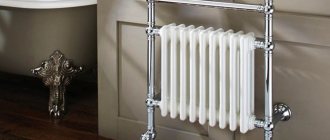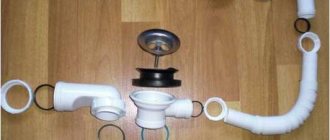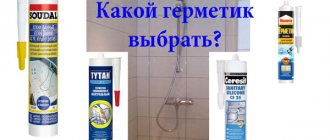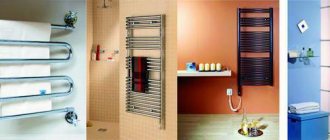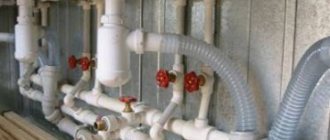This necessary device rarely fails, and it usually only needs to be replaced during a major renovation, when replacing the rest of the contents of the bathroom. An old heated towel rail simply doesn’t look right against the backdrop of a decent renovation.
Despite its apparent simplicity, replacing a shabby iron “monster” with a modern, elegant design coated with chrome or enamel should be done very carefully, adhering to certain requirements. The fact is that the heated towel rail is also a so-called compensating loop. The domestic heat supply system is designed in such a way that a vertical pipe—a riser—passes through all floors from top to bottom. In addition, all vertical pipes are connected to each other in the attic and in the basement of the building (that is, “looped”).
As the water temperature increases, the pipes through which hot water flows can “lengthen” a little (according to the laws of physics), and when it decreases, they can “shorten” accordingly. Pipes especially suffer during summer hot water outages. Now mentally imagine a hot water pipe from the first to the last floor, that is, the entire riser. Heated towel rails on each floor act as compensators; this entire system, reminiscent of an accordion, seems to breathe and “play.” It is for this reason that no accidents caused by temperature changes occur.
Therefore, when renovating your bathroom, it is advisable to have a heated towel rail that will “fit” into the place of the old one. Unfortunately, imported heated towel rails do not always meet the requirements. Below are tips to help you decide on this product.
Types of heated towel rails
Types
There are two main types of heated towel rails:
- Water - they are connected directly to the hot water supply system.
- Electric - as their name implies, such heated towel rails are connected to the electrical network.
When choosing a heated towel rail for the bathroom, you should pay attention not only to the type of device, but also to factors such as the size of the heated towel rail, as well as the area of the heated room.
Forms
Heated towel rails also vary in shape. At its core, this device is a curved pipe that can have a variety of shapes. The most common forms are:
- U-shaped coils are similar to the letter P rotated 90°.
- M-shaped coils are similar to the letter M rotated 90°.
- Ladder - similar to a ladder.
- Foxtrot is a combination of two coils: an external U-shaped one and another internal one.
Foxtrots and ladders have a large heating area, which allows them to easily heat a fairly large room; in addition, they can accommodate more things to dry and dry faster due to the greater adherence of the fabric to the heated towel rail.
You can find out the corner dimensions of bathtubs in this article. And here about the sizes of cast iron bathtubs.
Material
The material from which heated towel rails are made is no less important; let’s take a closer look at them:
Steel
You won’t find such heated towel rails on sale, but in old houses, and even in some new ones, heated towel rails are simply made from an ordinary curved steel pipe. Their advantage is that they are cheap, and in addition, as practice shows, they work for years.
Stainless steel
They can withstand high pressure, are heavy, and come in chrome plated or painted in various colors. When choosing, be sure to look at the thickness of the pipe walls; they should be at least 3 mm.
Copper
High thermal conductivity, anti-corrosion resistance, lightness, appearance. When purchasing, please note that the inner surface of the pipe walls must be galvanized to maximize the protection of the pipe from water.
Brass
They have the advantages of copper heated towel rails; they are cheaper, but more fragile. When purchasing, choose heated towel rails with chrome-plated inner walls. They can be recommended for installation in autonomous heating systems.
Connection
In plumbing, it is customary to measure diameter in inches (one inch is equal to 25 mm). The standard diameter of riser pipes in our homes is one inch or an inch and a quarter. Most imported heated towel rails have different “connection sizes” - either half an inch or 3/4 inch. In general, you will have to tinker.
When choosing a heated towel rail, you must consider two points:
- what pressure in the water supply network is it designed for;
- pressure in your water supply.
The amount of pressure in the water supply network is regulated by regulatory documents - Construction Norms and Rules (SNiP) and GOSTs. In accordance with GOSTs, all water fittings (mixers, etc.) must operate without problems at a pressure of 6 atmospheres (or in other words, bar; 1 bar can be conventionally considered equal to 1 atmosphere) and withstand pressure testing of 10 atmospheres. (Crimping is excess pressure, which is used once or twice a year to check the water supply (and heating) system for water leaks or possible breaks in the pipes.)
Theoretically, water pressure should not exceed 4 atmospheres, but, unfortunately, this is only a theory. In practice, the water pressure in the network can vary from 2.5-3 atmospheres to 7.5 or more at the entrance to the apartment. It all depends on the area, floor, type of house, state of communications.
So before buying a heated towel rail, find out what the pressure is in the water supply of your home, and do not forget to add some margin of safety for water hammer, that is, sudden surges in pressure in the water supply. And ask the seller what operating and pressure testing pressure the heated towel rail you like can withstand. All the necessary pressure indicators must be in the product passport or technical specifications.
If you are going to use a heated towel rail in a country house, you can safely purchase any: the pressure in the internal system of your mansion is unlikely to exceed 2-3 atmospheres.
Domestic heated towel rails, for example, produced in Kimry (Tver region) have a pipe diameter of one inch or 3/4 inch. Similar products from Kazan or Tula craftsmen - one inch. Naturally, there will be no problems with installing them in place. According to sellers, our heated towel rails are designed for an operating pressure of 16 atmospheres and a test pressure of 22 atmospheres.
Heated towel rail sizes
dimensions
Different forms of heated towel rails have different dimensions. U-shaped coils are the smallest, Ladder coils are the largest:
- U-shaped coils: height 32 cm, width 40-80 cm.
- M-shaped coils: height 50-60 cm, width 40-80 cm.
- Ladder: height 50-120 cm, width 50-80 cm.
- Foxtrot: height 32-60 cm, width 40-80 cm.
Connection dimensions
Heated towel rails are available for sale with the following diameters:
- ½" - outer diameter 19 mm. Foxtrots, ladders.
- ¾" - outer diameter 25 mm. P and M-shaped coils.
- 1″ - outer diameter 32 mm. All forms.
- 1 1/4″ - Outer diameter 40 mm. U-shaped coils and foxtrots.
Heating area
Size of water heated towel rail and volume of heated bathroom:
- 50x40 cm - 4.5-6 m³
- 50x50 cm - 4.5-6 m³
- 50x60 cm - 4.5-6 m³
- 60x40 cm - 6-8 m³
- 60x50 cm - 6-8 m³
- 60x60 cm - 6-8 m³
- 80x40 cm - 7.5-11 m³
- 80x50 cm - 7.5-11 m³
- 80x60 cm - 7.5-11 m³
- 100x40 cm - 9.5-14 m³
- 100x50 cm - 9.5-14 m³
- 100x60 cm - 9.5-14 m³
- 120x40 cm - 11-17 m³
- 120x50 cm - 11-17 m³
- 120x60 cm - 11-17 m³
- 120x80 cm - 11-17 m³
Electric heated towel rail power and bathroom volume:
- 500 W – 10 m³
- 750 W – 15 m³
- 1000 W – 20 m³
- 1250 W – 25 m³
- 1500 W – 30 m³
- 1750 W – 35 m³
- 2000 W – 40 m³
Material
To create modern heated towel rails, only three types of materials are used.
- Metal. This is the most budget option, which has many disadvantages. These include rapid rusting and peeling of the chrome plating. a thin-walled pipe is used to create equipment , which can quickly fail. For this reason, some consumers prefer to buy designs based on seamless pipe, but their price can be quite high.
- Stainless steel. Stainless steel appliances are a good option for any bathroom. However, it must be remembered that such equipment is influenced by “stray” currents, due to which the integrity of the structure may be compromised. Moreover, replacing the equipment yourself can be difficult due to the nature of the threaded connection. In some cases, the threads are blunted and then the joint is sealed with tow. It should also be noted that there is no protective coating. To make such a heated towel rail shine, it is simply polished.
- Copper. Copper structures can safely be called eternal. Their main disadvantage is their high cost, but such equipment will last a very long time and retain its characteristics.
Connection methods
If your choice is a water heated towel rail, then you should pay attention to the connection method, which comes in 3 types:
- Direct - the method used most often, suitable for ladders and coils.
- Bottom - used for large ladders, but requires good coolant pressure.
- Diagonal - suitable for large heated towel rails, provides effective heat transfer from the coolant, but requires a longer pipe length.
Location of water and electrical appliances according to GOST: distance from the wall
The distance between the wall and the product depends primarily on the diameter of the dryer pipes. According to GOST, the equipment is installed in such a way that there is a gap of 3.5 to 5.5 cm .
For example, with a pipe diameter of 2.3 cm, during installation of the product the distance from the wall will be 3.5 cm . This is the minimum distance required for normal convection of warm air. With a diameter of more than 2.3 cm, it is recommended to retreat from the wall by 5-5.5 cm .
These conditions are observed when installing both water and electrical equipment. And also when installing an electrical device, the location of the outlet is taken into account : it is safer to place the outlet no closer than 0.7 m from any pipes and other plumbing items .
Summarizing
You cannot purchase a heated towel rail solely based on individual preferences. The device should not only keep towels dry, but also heat the room. Choosing the wrong size will result in the bathroom simply not warming up properly. The aesthetic component is also important. You should never rush into a purchase. They always pre-measure the location of future installation and calculate the optimal size. In addition, you should pay attention to the protection class, which is indicated in the passport for the heated towel rail. Experts recommend choosing models whose indicators are 22 and 24. The first number means protection from damage, and the second from moisture.
Design and color
Manufacturers strive to satisfy any requests and produce heated towel rails that can harmoniously combine with the rest of the details of any interior. You can choose the best option for any style. For a room with a modern design, a chrome, white, silver or black product is suitable. The nobility of the classics will be supported by a copper or brass model. Black or steel shades will fit perfectly into industrial styles.
